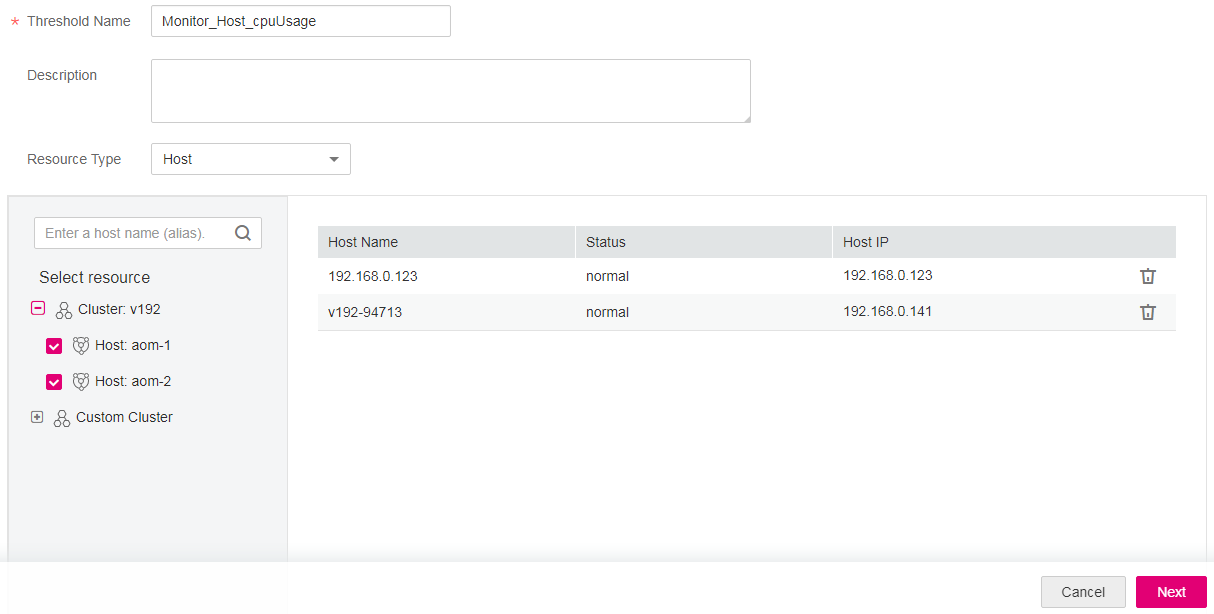Creating Threshold Rules¶
To use threshold rules, customize threshold conditions first. If a metric value meets a threshold condition, AOM generates a threshold alarm. If no metric data is reported, AOM generates an insufficient data event.
AOM is interconnected with Simple Message Notification (SMN). After you set a notification policy on the SMN console, notifications are sent by email or Short Message Service (SMS) message if the threshold rule status (Exceeded, OK, or Insufficient) changes. In this way, you can identify and handle exceptions at the earliest time.
Precautions¶
You can create a maximum of 1000 threshold rules. To create more rules when the maximum number is reached, delete unnecessary rules.
Setting a notification policy
To send notifications by email or SMS message if the threshold rule status (Exceeded, OK, or Insufficient) changes, set a notification policy on the SMN console according to the following procedure. If you do not need to receive notifications by email or SMS message, skip the following operations. Procedure:
Create a topic by referring to Creating a Topic.
Set a topic policy by referring to Configuring Topic Policies.
Select apm for Services that can publish messages to this topic. Otherwise, notifications cannot be sent.
Add a subscriber (email or SMS message recipient) for the topic by referring to Adding a Subscription.
Creating Threshold Rules¶
Log in to the management console.
Under Application, click Application Operations Management.
In the navigation pane, choose Alarm Center > Threshold Rules. Then, click Add Threshold Rule in the upper right corner.
Create a threshold rule.
Select resources: Enter a threshold rule name, select a resource type, select the resources to be monitored from the resource tree, and click Next.
Note
You can select a maximum of 10 resources from the resource tree.
When multiple resources are selected, multiple threshold rules will be created after the creation is complete. Each resource is monitored by a threshold rule. A rule name consists of the threshold rule name you enter in the Threshold Name text box, and a sequence number ranging from 0 to 99. The earlier a resource is selected, the smaller its sequence number.
For example, enter Monitor_Host_cpuUsage in the Threshold Name text box and select the aom-1 host and then the aom-2 host from the resource tree. In this way, threshold rules Monitor_Host_cpuUsage0 and Monitor_Host_cpuUsage1 will be generated. The former monitors the aom-1 host while the latter monitors the aom-2 host.

Figure 1 Selecting resources¶
Customize a threshold. Specifically, select the metric to be monitored, and set parameters such as Threshold Condition, Consecutive Period (s), Alarm Severity, Statistic, and Send Notification.
Note
Threshold Condition: Trigger condition of a threshold alarm. A threshold condition consists of two parts: determination condition (>=, <=, >, or <) and threshold value. For example, if Threshold Condition is set to > 85 and an actual metric value exceeds 85, a threshold alarm will be generated.
Consecutive Period (s): If a metric value meets the threshold condition for a specified number of consecutive periods, a threshold alarm will be generated.
Statistic: Method used to measure metrics.
Statistical Period: Interval at which metric data is collected. The system collects a data point every minute to determine the status of the threshold rule.
Send Notification: Whether to send a notification by email or SMS message if the threshold rule status (Exceeded, OK, or Insufficient) changes.
If you need to receive notifications by email or SMS message, select Yes, set a notification policy, select the created topic, and select a trigger condition.
If you do not need to receive notifications by email or SMS message, select No.
Trigger Condition: Condition for sending notifications.
You can select multiple trigger conditions for a threshold rule. For example, to receive notifications if the threshold status changes to Exceeded, select Threshold crossing. To receive notifications upon any threshold status change, select all trigger conditions.

Figure 2 Customizing a threshold¶
Click Submit. As shown in the following figure, multiple threshold rules are created. Each resource is monitored by an independent rule.
If the CPU usage of a host exceeds 85%, a threshold alarm is generated on the alarm page. You can choose Alarm Center > Alarms in the navigation pane to view the alarm. If the host meets the preset notification policy, an email or SMS message will be sent to the specified recipient.

Figure 3 Threshold rules¶
 .
. next to a threshold rule to view its details.
next to a threshold rule to view its details.